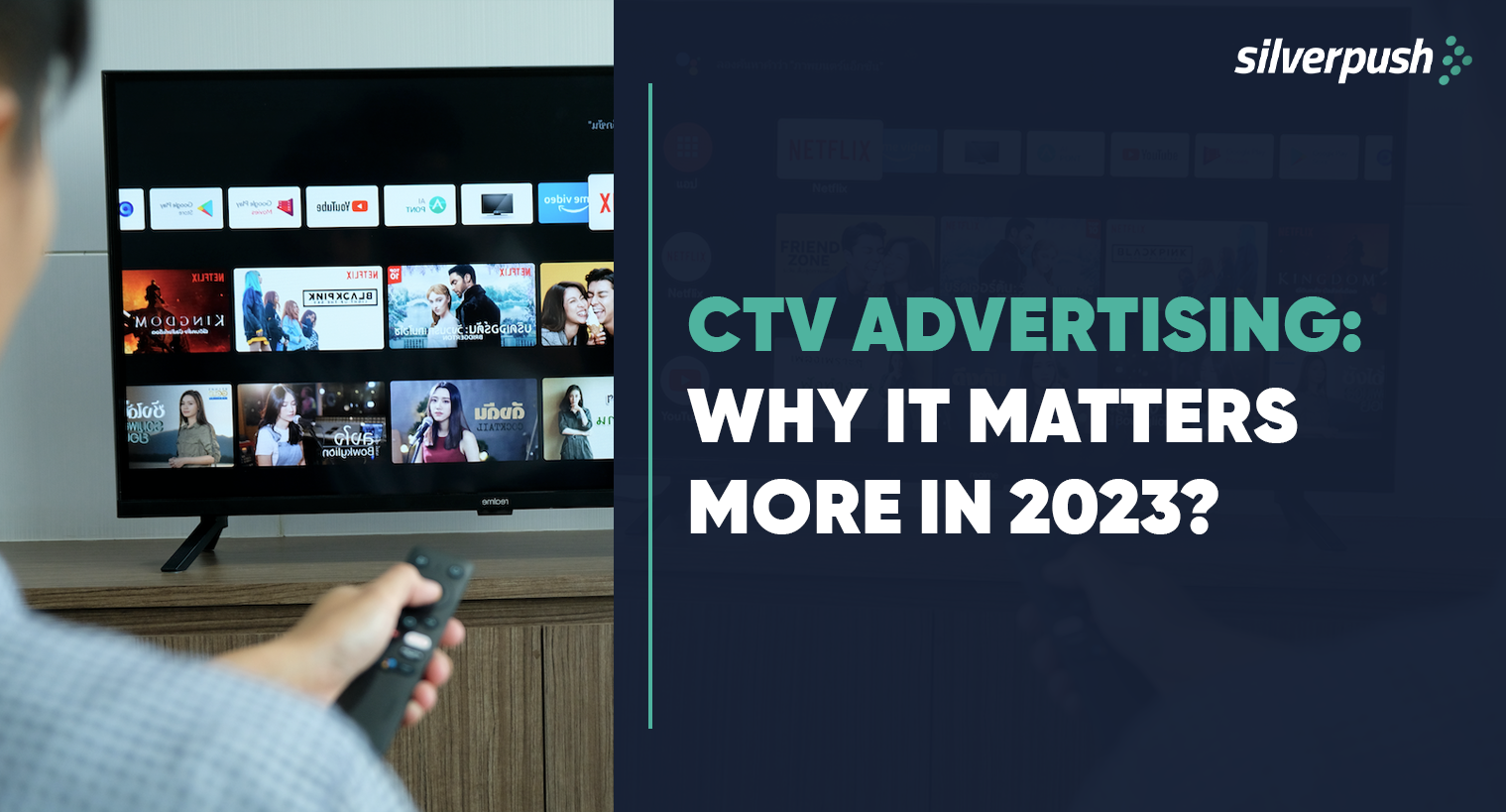Why Should You Care about CTV Advertising in 2024? | 16 Dec, 2022

Learn why CTV advertising should be in the marketing mix of brands in 2024.
Introduction
After several years in the dark, it’s finally time for connected TV (CTV) to enter the limelight. Connected TV is the darling of 2020. With much of the world under lockdown, the quantity of over-the-top (OTT) content consumed on CTV devices has skyrocketed, and this trend is only expected to continue.

86% of consumers are willing to see CTV ads that are relevant to them or entertaining, but 40% of the audiences are expected to reject CTV if there are too many ads. (MarTech)
This is the primary reason why buyers are planning significant increases in their CTV ad budget in 2024. According to IAB, ”Buyers are reallocating ad spend on CTV from broadcast (53%) and cable TV (52%) advertising.
CTV and OTT devices are quickly gaining momentum and will soon be among the main video advertising platforms. If you’ve realized how significant CTV will be in 2024, this blog is for you! Dive deep into this article to grasp the essence of CTV, how it works, and what’s in store for 2024.
What is Connected TV (CTV)?
Before moving forward, it is important to understand what CTV means in advertising. A connected TV is a device that is used to stream video content over the internet. There are different types of CTVs including:
1. Smart TVs

A Smart TV is an internet-connected television set that contains free and paid services such as YouTube, Netflix, Hulu, and others, eliminating the need for an add-on streaming device.
2. Connected Devices

These are over-the-top, or OTT, devices that plug directly into a television set, connect to the internet, and feature both free and paid streaming programs such as YouTube, Hulu, and others.
3. Gaming Consoles

Streaming apps on gaming consoles such as Xbox, Playstation, and Nintendo may be used to broadcast video content to television sets.
What is CTV Advertising?
CTV advertising or Connected TV advertising, allows brands to reach their audience on CTV and OTT devices. The advertising takes place via downloaded applications that stream video content such as television shows. Brands can target their audience on CTV by displaying ads on premium, ad-supported shows provided by top-tier networks with complete brand safety for CTV.
What’s the Difference Between CTV and OTT?
The Video Advertising Bureau (VAB) defines OTT as “premium long-form video content that is streamed over the internet through an app or device onto a TV (or PC, tablet, or smartphone) without requiring users to subscribe to a wired cable, telco, or satellite TV service.” Connected devices are defined by VAB as “internet-streaming players, game consoles, and connected TVs.”

Why is CTV Advertising Taking Center Stage in 2024?
Sooner than expected, connected TV advertising has become the most demanded platform by brands to reach their target audience. Below are some of the statistics on CTV which prove why.
Top CTV Advertising statistics
1. 98% of brands believe connected TV advertising will be bigger than mobile in the next two to three years. (MarTech)
2. CTV ad impressions account for half of all video ad impressions, (nearly double that of mobile). (Invoid and Digiday)
3. CTV is now mainstream—over one-third of American households have shifted to streaming as their exclusive source of television entertainment. (National Library of Medicine)
4. As of 2022, 87% of US TV households have at least one Internet-connected TV device. (Leichtman Research Group)

5. In 2022, there will be 60.5 million monthly connected TV users among Millennials, and it’s estimated this number will hit 62.6 million by 2025 (+2.1 million growth). (Statista)
6. Connected TV ad spending increased by 57% in 2021 and reached 15.2 billion US dollars. It’s estimated to grow by 39% and hit 21.2 billion US dollars in 2022. (IAB)
7. 63% of respondents say CTV ads can allow more precise audience targeting. (Invoid and Digiday)
What’s Stopping US Marketers from Investing in CTV Ads?
Along with the looming brand safety risks for CTV advertising, there are several other factors that are forcing brands to step back from advertising on CTV and OTT devices.
As per a report by eMarketer, there are several factors that influence the ad spending of US Advertisers, the main ones are:
- 47% of marketers worldwide would spend more on CTV advertising if they had access to higher-quality targeting data.
- 36% are looking for a more efficient buying or planning process.
Brand Safety Issues in CTV
In spite of having so many advantages, just like other channels, even Connected TV advertising is not spared from brand safety risks. There is a high risk of running ads alongside objectionable content on CTV The same variety of apps and content that other platforms have also existed on CTV. Many aren’t aware, but there are adult apps, screensaver apps, etc. on CTV. In short, CTV is not just premium television.
Does displaying ads on Premium CTV inventory solve the brand safety issue?

How will Contextually Targeting on CTV and OTT Platforms Help?
It is important to understand viewers and their preferences in all types of media. However, engaging with them through relevant ads is much more important.
If you don’t reach that viewer in a contextually relevant environment, then all you have left in the end is a wasted opportunity.
Users are more likely to see and respond to ads that are relevant to the context in which they are seen.
If the content and offers in the TV ad are relevant to what the individual is seeing, there is a greater possibility the person can be converted into a consumer.
On the other hand, if ads aren’t appropriate to the context they are viewing, people may find them unpleasant, obtrusive, and irrelevant, negatively impacting their connection with the brand and product offering.
Needless to say, advertisers aiming to boost the long-term impact of their TV ad content and the loyalty it may engender from consumers would benefit greatly from this alignment between context and digital advertising.
Context is everything, all the time. It is important in Connected TV ads as well!

BLOGS
Breaking Tradition: Innovative Marketing Strategies for Vietnam Tet 2025
One of the most significant cultural events for the Vietnamese, Tết Nguyên Đán, or the Vietnamese Lunar New Year, is almost here. Marking the beginning of spring, this time of year has, for generations, been a season for family gatherings, delicious feasts, and honoring ancestors. The week-long holiday witnesses the ...

BLOGS
5 Proven Black Friday and Cyber Monday Marketing Strategies for 2024
Black Friday and Cyber Monday (BFCM) are no longer exclusive to the U.S. market. It has gone global and is now one of the most important dates when every business wishes to ensure a spike in their online or in-store sales. With customers hunting for the deal, e-commerce businesses and ...

BLOGS
Why News Content is a Goldmine for Advertisers: Debunking Brand Safety Myths
Brand safety concerns have long clouded advertising alongside news content. As a marketer and advertiser, you might think twice before placing your ads against news stories, fearing harm to the reputation of your brand. However, new findings by Stagwell challenge those longtime fears, showing that advertising in news environments could be ...







